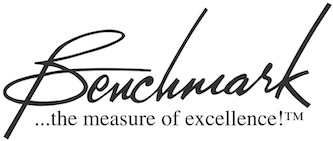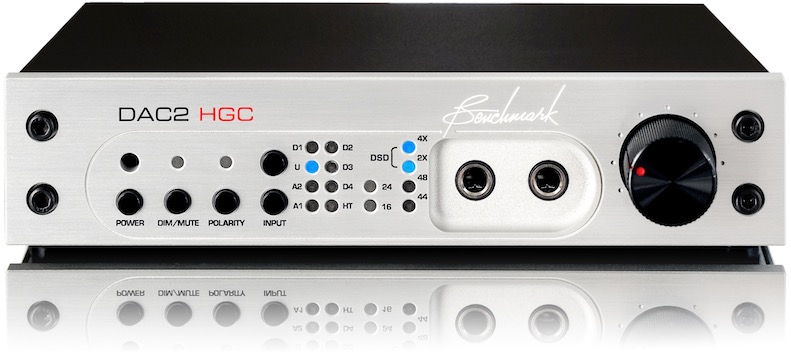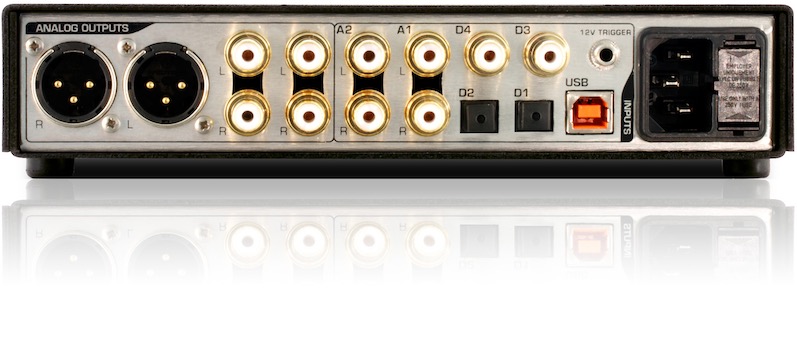amp/DAC
Benchmark DAC2 Rave in Stereophile
09 02, 14
The Benchmark DAC2 HGC, in essence a digital preamp/DAC/amp for those who run fully digital rigs and high-end headphones, got a rave write-up in Stereophile. I take some flak from head-fi forum folks for liking these cutting-edge, fully-digital front ends to the exclusion of separates and tube gizmos, but it's hard to argue that the Benchmark electronics are not state-of-the-art. What I like most is that they're easy to haul around, whether to shows or just back and forth from my office to my house. I keep an older DAC1 plugged in on my nightstand, but I take it out for demos to customers too.
I take issue with the seemingly reflexive assumption on the part of the Stereophile reviewer that the DAC2 is better because it's now more expensive, or relatedly that a unit from another maker that costs twice as much has an edge over the Benchmark. For that matter, I take issue with comparisons of the Benchmark with $500 units. For me, the Benchmarks have a sort of studio-quality, throwback, precision instrument feel that allows -- and I blush to say it, because it's so materialistic -- pride of ownership. Oh well, it's not like I bought a Porsche with leather radio knobs or anything. Plus which, I can honestly say I feel confident that the Benchmarks are rugged and will last forever, meaning they're a reasonable value.
I am glad that Stereophile has taken up where my old favorite, Audio Magazine, left off, providing solid testing along with the written reviews. When I see equipment reviewed there or elsewhere, such as Absolute Sound or, now, Sound and Vision, without any testing and with lots of highly subjective commentary, I sort of scratch my head why those publications are operating as mass publications. I mean, that's pretty much just blogging, right?
I take issue with the seemingly reflexive assumption on the part of the Stereophile reviewer that the DAC2 is better because it's now more expensive, or relatedly that a unit from another maker that costs twice as much has an edge over the Benchmark. For that matter, I take issue with comparisons of the Benchmark with $500 units. For me, the Benchmarks have a sort of studio-quality, throwback, precision instrument feel that allows -- and I blush to say it, because it's so materialistic -- pride of ownership. Oh well, it's not like I bought a Porsche with leather radio knobs or anything. Plus which, I can honestly say I feel confident that the Benchmarks are rugged and will last forever, meaning they're a reasonable value.
I am glad that Stereophile has taken up where my old favorite, Audio Magazine, left off, providing solid testing along with the written reviews. When I see equipment reviewed there or elsewhere, such as Absolute Sound or, now, Sound and Vision, without any testing and with lots of highly subjective commentary, I sort of scratch my head why those publications are operating as mass publications. I mean, that's pretty much just blogging, right?
Nice Cans now sells and stocks Benchmark
30 10, 13
I've picked up a line I've long admired (and owned), Benchmark Media Systems.

They make small, precision-engineered digital front ends with stout headphone amps as separate modules (and even separately configurable, with or without). Lately, they've broadened their lines with more connection possibilities, including more analog interface options. Thus, you can use the Benchmarks solely as DACs that feed a geek-out tube amp. You can even order them without the internal headphone amp so you get better value.
These guys all have remote controls.
I like these products because they are at the pinnacle of digital-to-analog conversion, using the latest technology. They're small and easy to tote around, but full-featured and very sophisticated. I strongly doubt that a DAC can be much better, so the issue for me will be whether the ergonomics and headphone mating are equally solid. I'll report back on these issues.
At least one Head-Fier has accused me of being in love with small, complete, all-in-ones. It's true. I personally don't run tube equipment and prefer to upgrade periodically to the best digital-to-analog conversion I can afford. You can pay more for a DAC than Benchmark's, but I doubt you can get much marginal additional benefit.
I'll be ordering the new DAC2-HGC, which is in essence a complete system front end for even a 2.1 stereo setup.


Important for my purposes, however, it's got two headphone jacks in front and a robust amp driving them. I'll be comparing it with my favorite solid-state device, the Fostex HP-A8C amp/DAC, which I've blogged about before. I suspect the products will sound identical, but the Fostex's ergonomics could be better. The Fostex is very pretty. Only a hard-core device geek like me would call the Benchmarks pretty -- they look like they belong in a warship skipper's bridge (that's a compliment, by the way). The pricing is roughly the same for both products. I'll tote both as my demonstrators at the upcoming Austin Head-Fi Meet in January, 2014.

They make small, precision-engineered digital front ends with stout headphone amps as separate modules (and even separately configurable, with or without). Lately, they've broadened their lines with more connection possibilities, including more analog interface options. Thus, you can use the Benchmarks solely as DACs that feed a geek-out tube amp. You can even order them without the internal headphone amp so you get better value.
These guys all have remote controls.
I like these products because they are at the pinnacle of digital-to-analog conversion, using the latest technology. They're small and easy to tote around, but full-featured and very sophisticated. I strongly doubt that a DAC can be much better, so the issue for me will be whether the ergonomics and headphone mating are equally solid. I'll report back on these issues.
At least one Head-Fier has accused me of being in love with small, complete, all-in-ones. It's true. I personally don't run tube equipment and prefer to upgrade periodically to the best digital-to-analog conversion I can afford. You can pay more for a DAC than Benchmark's, but I doubt you can get much marginal additional benefit.
I'll be ordering the new DAC2-HGC, which is in essence a complete system front end for even a 2.1 stereo setup.


Important for my purposes, however, it's got two headphone jacks in front and a robust amp driving them. I'll be comparing it with my favorite solid-state device, the Fostex HP-A8C amp/DAC, which I've blogged about before. I suspect the products will sound identical, but the Fostex's ergonomics could be better. The Fostex is very pretty. Only a hard-core device geek like me would call the Benchmarks pretty -- they look like they belong in a warship skipper's bridge (that's a compliment, by the way). The pricing is roughly the same for both products. I'll tote both as my demonstrators at the upcoming Austin Head-Fi Meet in January, 2014.
Leckerton UHA-6S.MKII amp/DAC review
16 03, 13
Local manufacturer of portable headphone electronics Leckerton Audio loaned me their UHA-6S.MKII portable amp/DAC for the March 2 headphone meet in Austin, and I've continued using and listening to the device. I already use a Ray Samuels portable as well as a Headroom, but both those are amps without DACs. The Leckerton unit is also a DAC. I conducted most of my listening using an Apple digital camera connector adapter attached to an iPad with .wav files. I also tried out the regular analog line-in using a dock connector adapter from Apple devices. The Leckerton amp/DAC is a mighty little thing that sounds terrific.
The first thing I noticed switching to a DAC/amp combo from a standard analog line in was a dead-silent background. I hadn't really considered that -- I assumed I'd be listening for some sort of specific tonal differentiation. I'm not sure I ever hear that amongst high-quality electronics, but I feel comfortable saying that with the digital-in signal, the noise floor went to absolute black. I heard my own heart and in-ear resonance instead of any trace of anything from the amp. Classical choral and instrument voices come up out of nowhere. Cool.
I most often listen to headphones in a living room chair or in bed, nowhere near my media room or an AC plug-in amp. Accordingly, I'm nearly always using a portable amp of some kind. I tried out the Leckerton with Audeze, Beyerdynamic, and Fostex flagship cans, and it pumped out more than enough volume for me, especially at the high-gain setting. I think the Leckerton estimates for battery life are conservative. Even with the DAC running, I've gotten more than 15 hours of listen time.
The action of the volume control is dead-silent, for those who care. I found it easier to use the textured volume controller on the Leckerton than the smooth one on the RSA. The Leckerton also has a more silky feel and turns rather easily. It never turned too easily, however -- that is, my normal movements didn't cause the volume to change.
I don't deal in Leckerton -- all the sales are mfr.-direct -- so I have nothing at stake in this game. I plan to switch all my portable listening to the little Leckerton unit. The only limiting feature I have found thus far is the source that's plugged into it -- my Apple laptop is a headache right now because of some sort of sample-rate issue when I interface with any high-bitrate DAC. I've got to suss that out. The sound from my iPod classic and iPad was pristine, however.
The first thing I noticed switching to a DAC/amp combo from a standard analog line in was a dead-silent background. I hadn't really considered that -- I assumed I'd be listening for some sort of specific tonal differentiation. I'm not sure I ever hear that amongst high-quality electronics, but I feel comfortable saying that with the digital-in signal, the noise floor went to absolute black. I heard my own heart and in-ear resonance instead of any trace of anything from the amp. Classical choral and instrument voices come up out of nowhere. Cool.
I most often listen to headphones in a living room chair or in bed, nowhere near my media room or an AC plug-in amp. Accordingly, I'm nearly always using a portable amp of some kind. I tried out the Leckerton with Audeze, Beyerdynamic, and Fostex flagship cans, and it pumped out more than enough volume for me, especially at the high-gain setting. I think the Leckerton estimates for battery life are conservative. Even with the DAC running, I've gotten more than 15 hours of listen time.
The action of the volume control is dead-silent, for those who care. I found it easier to use the textured volume controller on the Leckerton than the smooth one on the RSA. The Leckerton also has a more silky feel and turns rather easily. It never turned too easily, however -- that is, my normal movements didn't cause the volume to change.
I don't deal in Leckerton -- all the sales are mfr.-direct -- so I have nothing at stake in this game. I plan to switch all my portable listening to the little Leckerton unit. The only limiting feature I have found thus far is the source that's plugged into it -- my Apple laptop is a headache right now because of some sort of sample-rate issue when I interface with any high-bitrate DAC. I've got to suss that out. The sound from my iPod classic and iPad was pristine, however.
